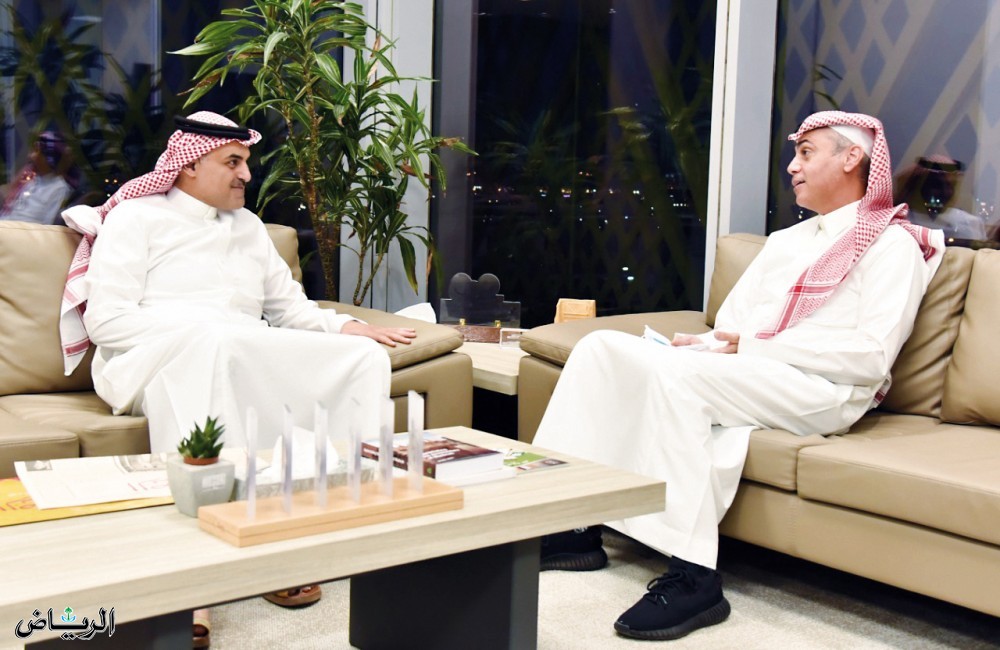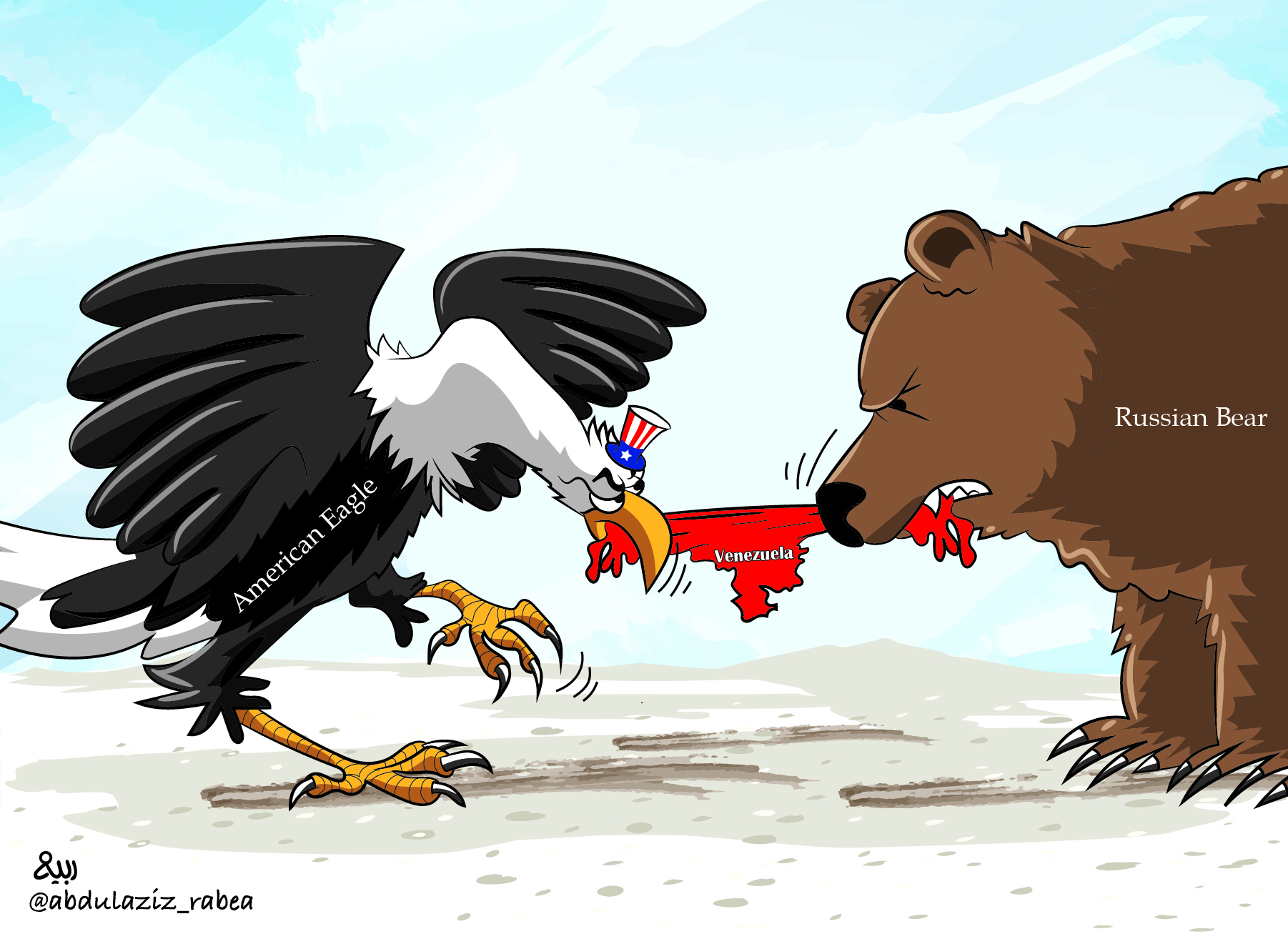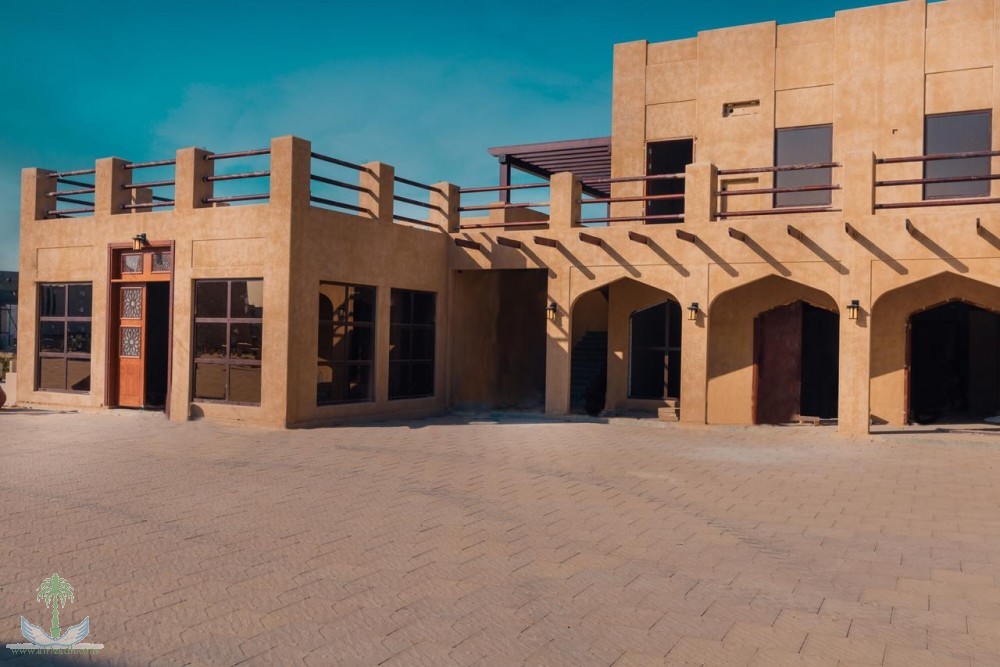 Mr. Aiman Al Mudaifer (L) with Khaled Al-Rubaish
Mr. Aiman Al Mudaifer (L) with Khaled Al-Rubaish
The Public Investment Fund supports raising the rate of home ownership by hosting two million new residents
A high-ranking official in the Public Investment Fund (PIF) revealed that the fund, through its ambitious strategy, intends to launch promising vital sectors that contribute to empowering the private sector. The anticipated strategy aims to increase the contribution to local content up to 60% at the fund and its affiliates, as the PIF is committed to distributing its investments around 80% locally and 20% internationally. Mr. AIMAN bin Muhammad ALMUDAIFER, Head of the Local Real Estate Investments at Public Investment Fund, said that the PIF is linked to one of the three pillars of the Kingdom's 2030 vision including the “achievement of a prosperous economy” through developing and diversifying the economy. He also pointed out that the fund has a key role in backing development efforts and economic diversification in the Kingdom.
In his first press interview, Mr. AIMAN ALMUDAIFER unveiled that the PIF, in the forthcoming years, is discussing many goals, most notably pumping at least SR 150 billion per year into new local projects on an increasing scale until 2025. These local projects will be spread over the portfolio of developing the promising sectors, the portfolio of real estate projects and infrastructure development along with the portfolio of mega Saudi projects.
In his expanded interview with “Riyadh” newspaper, he made clear that the PIF established a competent department to support national development and enhance the economic impact of the fund's investments. The competent department’s most important goals are the focus on the private sector participation, securing supply chains, and raising the level of localization. Regarding the King Abdullah Financial District (KAFD), Mr. AIMAN ALMUDAIFER said that since the PIF’s acquisition of KAFD, many contracts have been signed to complete the construction work with a total value amounting to more than SR 8 billion. In addition, a significant progress has been made, which contributed to the start of the partial operation and the leasing of spaces and buildings in the project, as some banks and companies rent units in “KAFD” are currently doing their business together with some tenants in the residential towers that have been operated. We expect an increase in demand as more buildings are ready.. To the details of the dialogue:
- What is the role of the PIF as a driver for strategic and sustainable economic diversification in compliance with the objectives of Vision 2030?
The PIF coherently proceeds to achieve the ambitious Saudi Vision 2030, as it is linked to one of the three axes of the vision. These axes are to achieve a prosperous economy through developing and diversifying the economy. The PIF has a key role in supporting development and economic diversification efforts in the Kingdom of Saudi Arabia. This aims to maximize the PIF’s assets, launch new sectors, build strategic economic partnerships, and localize technologies and knowledge.
It is noteworthy that the Kingdom’s Vision 2030 is based on unlocking the potential of the promising non-oil sectors. In this aspect, the PIF is an effective tool to enhance the Kingdom's efforts to diversify sources of income instead of depending oil revenues. Over the past three years, the PIF has managed to achieve a positive impact on the local economy and maximize sustainable returns along with duplicating its assets under the administration to SR 1.5 trillion by the end of 2020. It also contributed to activating 10 new sectors, which resulted in the creation of more than 331,000 direct and indirect job opportunities.
- What are the targets of the Fund's new strategy (2021-2025) from the perspective of local real estate portfolio - and mega projects?
The PIF, in the coming years, is discussing many targets, most notably pumping at least SR 150 billion per year into new domestic projects on an increasing scale until 2025. These local projects will be spread over the portfolio of developing the promising sectors, the portfolio of real estate projects and infrastructure development along with the portfolio of mega Saudi projects.
Through its diversified investments, the PIF seeks to create about 1.8 million new job opportunities whether directly and indirectly. This number includes the jobs created by the fund and its affiliates, or by other companies invested in the fund. These jobs will specifically include sectors such as hospitality and entertainment, real estate services, and construction sector.
The strategy themed “Development of local real estate projects” includes establishing development companies and supporting new companies in the real estate and infrastructure sectors within the Kingdom of Saudi Arabia. The projects are distributed to include various regions in the Kingdom. Initiatives, in this sector, aim to achieve several goals like raising the rate of home ownership in the Kingdom to 70%, developing the experience of Hajj and Umrah and raising the capacity of hotels and housing in Makkah and Madina together with developing urban communities at an international level, enhancing the quality of life in the Kingdom, investing in the tourism and entertainment fields, diversifying sources of revenue, and other goals.
Through “Developing mega projects” the PIF focuses on creating systems that contribute to launching and activating vital and strategic local sectors that depend highly on technology and localization of knowledge, such as future sciences, tourism, sports and real estate development. These projects support efforts of economic development in the Kingdom, promote investments and achieve returns in the medium and long term.
- What are the companies and achievements of the PIF in terms of developing its real estate assets and raising the level of quality of the infrastructure?
Mega and real estate projects contribute to developing and expanding the basic infrastructure in the Kingdom together with supporting economic development such as constructing airports, raising the level of environmentally friendly services in the fund's projects, in addition to discussing ways to improve and sustain water services, sewage treatment plants, and generate solar and wind energy and others. For instance, in July 2020, the “Saudi Real Estate Refinance Company” signed an agreement with the Public Pension Agency in order to obtain a real estate financing portfolio of more than SR 3 billion. This deal is considered the biggest in the real estate re-financing in the Kingdom, as the company's assets reached SR 6.1 billion in the third quarter of 2020.
The King Abdullah Financial District (KAFD) is the biggest mixed-use financial center in the region, and an integrated destination that combines housing, work and entertainment. This makes it a competitor to the most prominent global destinations, as it is considered a sustainable architectural masterpiece in the capital, Riyadh, and a key element in the Kingdom's Vision 2030. The Kingdom is currently carrying out this investment for the pivotal role that “KAFD” plays as an economic engine for the Kingdom, to become the main new destination for money and business in the region. Since the PIF’s acquisition of “KAFD”, many contracts have been signed to complete the construction work with a total value amounting to SR 8 billion. A significant progress has been achieved, which contributed to the start of the partial operation and leasing of spaces and buildings in “KAFD” where a number of banks and companies that rent units are currently doing business along with tenants in the residential towers that have been commissioned. We expect an increase in demand as more buildings become ready.

Mr. Aiman Al Mudaifer
- Are there new targeted sectors linked in the two portfolios?
During the next five years, the PIF aims to focus on 13 vital and strategic domestic sectors, namely the aviation and defense sector, vehicle sector, modern research, development and manufacturing activities, the tourism and entertainment sector, the minerals and mining sector, the utility sector and renewable energy in addition to the localization of the technology sector. These strategic sectors also include communications and media sector, real estate projects, the military industries sector, e-commerce, modern mega cities, recycling and logistics, investment in start-up funds along with sectors of water and energy. The PIF has selected these 13 priority sectors through:
• Assessing these sectors is based on the global and local perspectives in terms of analyzing the attractiveness of the market, its magnitude, expected growth and available opportunities
• Evaluating the sectors that can be stimulated and have a competitive advantage at the regional and global level, and its impact on the economy
• Setting priorities for sectors in accordance with the Kingdom’s Vision 2030 and programs to put them into action
• All sectors will contribute to achieving and shaping a better future for the local economy and community in general. Many of these sectors are linked to the local real estate portfolio and the mega projects portfolio
- What is the role of the private sector and its empowerment mechanism through the portfolio of real estate investments and the portfolio of the mega projects?
The PIF is currently carrying out an ambitious strategy through which promising vital sectors were launched to contribute to empowering the private sector. The anticipated strategy aims to increase the contribution to local content up to 60% at the fund and its affiliates, as the PIF is committed to distributing its investments around 80% locally and 20% internationally.
The PIF also develops important strategic partnerships with the private sector through mega projects, real estate projects, infrastructure projects and others with the aim of activating and revitalizing many important sectors such as housing, hospitality, tourism and entertainment. The PIF aims to involve the private sector with the purpose of contributing to raising the rate of the local content.
For examples, contracts worth SR 3.5 billion have been awarded to many domestic companies by Roshan Real Estate Development Company. In addition, the Qiddiya Investment Company has awarded several contracts with local companies worth SR 700 million to construct major storm water drainage, roads and bridges. The Red Sea Project also signed contracts worth SR 7.5 billion the share of local companies is 70% along with Saudi Arabia's Public Investment Fund (PIF) signed contracts worth more than SAR 8 billion for the construction works at King Abdullah Financial District (KAFD),
- Roshen, the national real estate developer for residential areas and one of the Public Investment Fund companies, tell us about this national company?
Roshen is a real estate development company and one of the Public Investment Fund companies in the Kingdom of Saudi Arabia. It aims to develop residential neighborhoods with high quality standards commensurate with the aspirations of the Saudi society. Roshen will take advantage of the opportunities available in the real estate market as a result of the great demand on the housing sector in the Kingdom, as well as contribute to increasing the percentage of housing units ownership to 70% in line with the objectives of the Public Investment Fund and the Kingdom’s Vision 2030. The project aims to develop residential communities on an area of more than 150 square kilometers, and to host more than two million residents from all segments of society.
Roshen announced its first neighborhood in the city of Riyadh, which extends over an area of more than 20 million square meters and includes more than 30,000 housing units, and it is the first neighborhood of Roshen to be implemented within a 10-year plan. It signed partnership contracts worth SR 3.5 billion to develop the first phase of the neighborhood, through 7 strategic partnerships. The first phase of the neighborhood includes 4 thousand housing units on a total surface area extending more than 3 million square meters. This neighborhood represents "Roshen" approach followed to develop its residential communities in various regions of the Kingdom. The neighborhood has been designed in a way that ensures modern urban architectural designs while preserving designs inspired by the original heritage of the Kingdom. The residential units will be available for sale off-plan during the first half of the current year. This will give investors and citizens the opportunity to own housing units high-quality housing units and integrated facilities commensurate with the aspirations of the Saudi society. These units will be available in a strategic location in the capital, Riyadh.
- What is the importance of mega projects and what is their impact on the citizen?
The PIF’s mega projects will contribute to developing and creating many sectors in the Kingdom, including tourism, sports, entertainment, and real estate development and these mega projects will represent important pillars of the Kingdom's economic future. As mentioned before, mega projects are designed to stimulate the economy and its positive effects are expected to extend beyond the real estate development and infrastructure sectors a matter which helps diversify the economy without relying on oil, especially because of its huge size. These projects also support efforts of the Kingdom’s economic development and promote investments in many sectors and in the same time achieve high returns in the medium and long terms, as they will serve as mega projects that support inspirations of the future generations.
Mega projects have already begun to attract the world's attention. For instance His Highness the Crown Prince has recently launched “The Line” that would extend over 170 km (105 miles) and be able to house a million residents in “carbon-positive urban development powered by 100% clean energy. The NEOM project witnessed the opening of the private airport in 2019, which will be the link between the project, the construction companies and the investors. In addition, Air Products, in conjunction with ACWA Power and NEOM, announced the signing of an agreement for a $5 billion world-scale green hydrogen-based ammonia production facility powered by renewable energy.
In QIDDIYA, the company signed an agreement with world-renowned theme park group “Six Flags” to develop and design a theme park bearing its brand in QIDDIYA that represents the first entertainment, sports and cultural destination in the Kingdom and it is expected to open in 2023. In addition, the master plan of the project was also approved, the stages for launching the project were determined and the Falcon’s Flight ride is already drawing attention for being the most “extreme” roller coaster in the world. QIDDIYA also hosted the final stage of the 2019 and 2020 Dakar World Rally.
A few days ago, His Royal Highness Prince Mohammed bin Salman bin Abdulaziz, Crown Prince has launched the “Coral Bloom concept”, which was created and designed to blend in with the island’s pristine natural environment. The Red Sea Development Company (TRSDC), the developer behind the world’s most ambitious regenerative tourism project, has since shared the striking vision for its main hub island at the destination, Shurayrah. The Red Sea Project signed contracts worth more than SR 7.5 billion within the plan to complete the first phase in 2023, and the share of local companies was 70% of these contracts in addition to the approval of the master plan of the project and the start of infrastructure works on its land. The Red Sea project scholarship program to study tourism was also launched, concluding with practical training and employment in the project upon their return.
- Could you tell us about the diversity of real estate projects developed by the PIF and spread over many regions of the Kingdom and its impact on the economic and social levels?
The PIF organizes its real estate initiatives in all regions of the Kingdom of Saudi Arabia. The PIF works to improve living standards and competitiveness in cities, through the development of new forms of urban communities, business centers, infrastructure projects, and new destinations through taking advantage of the Kingdom's natural, cultural and historical resources. The PIF also enhances the attractiveness and development of lifestyles in prominent Saudi cities together with improving access to entertainment services, expanding infrastructure networks in the Kingdom, and launching new destinations to benefit from the Kingdom's natural, cultural and historical resources.
For instance, the PIF is currently studying the “Wadi Disah Development Project” located within Prince Mohammed bin Salman natural reserve. The project aims to preserve the environment and the wildlife of the valley, and to exploit its tourism potentials including the moderate climate, distinctive mountainous terrain and flowing springs throughout the year to become one of the tourist attractions in the Kingdom. In addition, the PIF develops a new central Jeddah project on the waterfront of Jeddah governorate with a total surface area 5.7 square kilometers in a prime location on King Abdulaziz Road. The project aims to enhance the quality of life in Jeddah by providing many services such as public beaches with a length of 1.5 km, a museum with an industrial nature in cooperation with the Ministry of Culture along with a playground with international specifications to host international and local sporting events and a wide range of housing, hospitality, offices and retail shops.
- Finally ... What is the PIF’s financing mechanism for this large number of projects and ability at the same time to increase the rate of its assets and achieve its targets?
The PIF uses several sources to finance its business and investments. This includes four basic resources: increasing capital by the state, assets owned by the government that transfer its ownership to the fund, loans, debt instruments, retained returns from investments, in addition to participating with the private sector in those projects. The PIF adopts an ambitious growth strategy, which means that the optimal use of financing options and strengthening the financial position of the fund will be pivotal for several reasons:
• Maximizing risk-adjusted returns, increasing the diversification of the investment portfolio, and attracting the private sector
• Supporting capital recycling to invest in high-growth projects, which would help achieve the strategic objectives of the fund









